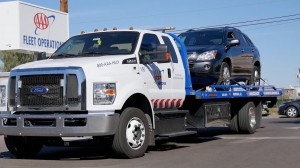The summer driving season is getting closer, although a look out one’s window may contradict that statement, and that means more driving and, more than likely, some sort of long-distance family trip.
While most folks start preparing for the inevitable rise in gas prices that will add costs to a trip, AAA warns that the majority of travelers should expect some sort of car trouble or breakdown while traveling the U.S.
A new analysis of AAA roadside data shows that vehicles 10 years and older are twice as likely to end up stranded on the side of the road compared to newer vehicles and on top of that, the odds of needing a tow quadruples.
The average age of a vehicle in the U.S. is more than 11 years old so before taking a road trip of any length, take your vehicle in for a check up.
(Mustang: World’s best-selling sports car for third year in a row. Click Here for the story.)
“It’s no surprise that older vehicles are more likely to encounter a serious breakdown, but it is surprising just how many people are at risk,” said John Nielsen, AAA’s managing director of Automotive Engineering and Repair.
“All vehicles – even the newest ones – are prone to typical roadside headaches like dead batteries, flat tires and misplaced keys, but vehicles 10 years and older are four times more likely to encounter a problem serious enough to require a tow to a repair facility.”
In order to catch trouble before it begins, AAA advises drivers make a good B-E-T to stay on the road by having a vehicle’s Battery, Engine and Tires checked before embarking on any kind of lengthy trip. Long trips coupled with hot weather places additional strain on vehicles and in some cases may accelerate a dormant issue.
(Click Here to see how a new road can charge your EV while you drive.)
When these key systems are in good working order, AAA data shows the odds of encountering a serious breakdown are greatly reduced. The top three types of vehicle issues that could derail a road trip are:
- Battery-related issues, including faulty starters or alternators. A battery on the brink of dying rarely warns a driver before it fails, but having a simple battery test will. Through its mobile battery program, AAA offers its members free testing of a vehicle’s battery and electrical system.
- Engine cooling system failures, such as the radiator, thermostat or water pump or engine parts such as the timing belt, most prominently in vehicles age 10 years and older. Much like a battery, the components of the engine cooling system may fail without warning. Drivers should look for fluids such as coolant pooling underneath the vehicle when it is parked as an indication of an impending problem.
- Tire damage severe enough to require repair or replacement. Drivers can minimize this risk by checking tread depth, tire pressure and whether their vehicle is equipped with a spare tire.
A professional and thorough vehicle inspection can help reduce the chance of a serious breakdown. If a car does end up at a repair shop, not only will a road trip be interrupted, drivers can expect to spend anywhere from several hundred to several thousand dollars to get back on the road.
(To see more about Toyota and Lexus adding V2X tech in cars by 2021, Click Here.)
“Drivers may skip taking their car in for an inspection, hoping to avoid an expensive repair bill,” Nielsen said. “But, when you factor in the cost of an interrupted trip, having a vehicle inspected and proactively repaired will cost much less in the long run.”


Don’t play in the street.
Eat your vegetables.
Wash your hands after going to the bathroom.